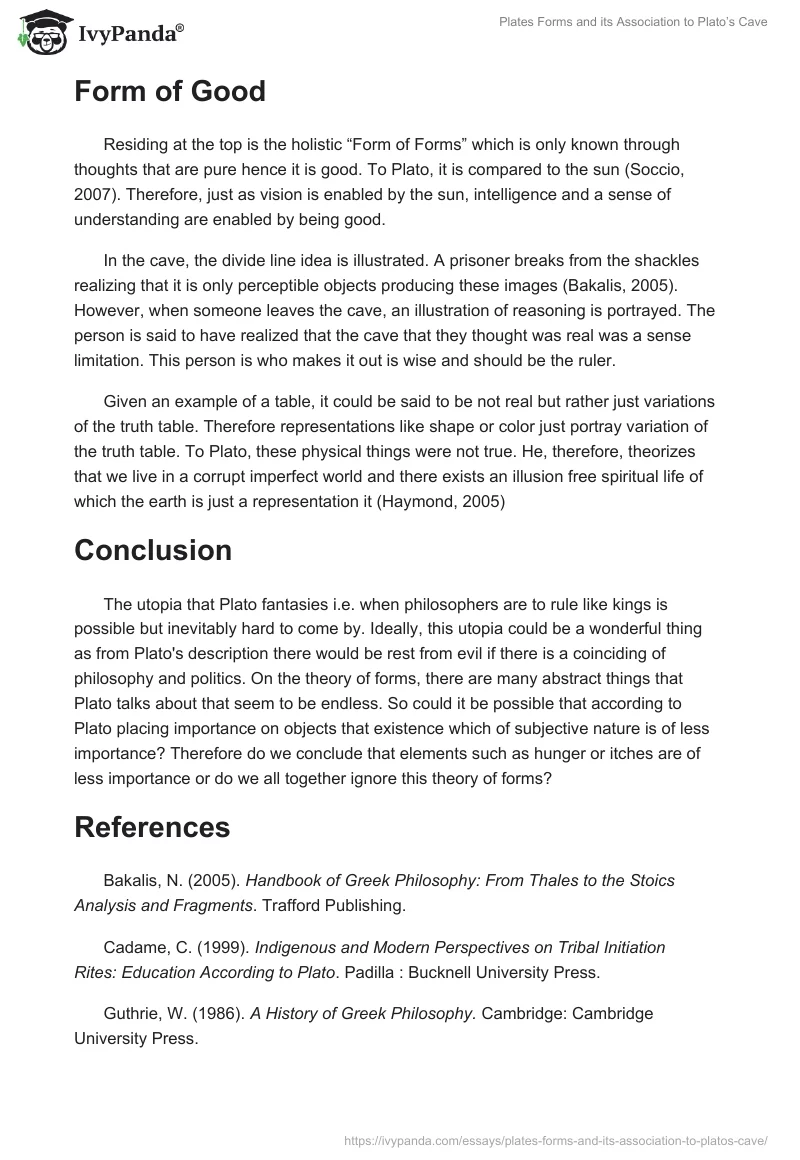Introduction
The theory of forms of Plato portrays to us that abstract non-material forms have the highest kind of fundamental reality as compared to this material world that is known well to us by sensation. The authors show Plato speaking about these entities through Socrates, he sometimes suggests the use of these forms. To him, these are the true and only study objects capable of providing genuine knowledge (Wright, 1966).
Theory of Forms
In the metaphysics of Plato, there exists a timeless essence; forms or as otherwise called entities, of being in a level. This metaphysics asserts the existence of a plane transcending beyond the ordinary general perception employed by us to things. Thus the name transcendental is used (Guthrie, 1986).
Plato wanted to provide an explanation that was rational through the forms of theory on how knowledge becomes possible e.g. physics, chemistry. He was also to identify the knowledge’s objects (Nails, 2002). He was also to provide a way of knowing if something is true knowledge or just an opinion i.e. identify the wise from the unwise. He does say in Timaeus that something that is gotten through reasoning is in that same state always while one by opinion never is and is ever in the becoming process (Cadame, 1999). This relationship is illustrated through Plato’s use of the dive line concept in which there are awareness levels from the level of imagination moving to the perception level, level of reasoning to the final level of understanding. A person can thus move through from imagination level to the level of understanding if he were to apply a hierarchical form way of thinking (Kahn, 2004).
Form of Good
Residing at the top is the holistic “Form of Forms” which is only known through thoughts that are pure hence it is good. To Plato, it is compared to the sun (Soccio, 2007). Therefore, just as vision is enabled by the sun, intelligence and a sense of understanding are enabled by being good.
In the cave, the divide line idea is illustrated. A prisoner breaks from the shackles realizing that it is only perceptible objects producing these images (Bakalis, 2005). However, when someone leaves the cave, an illustration of reasoning is portrayed. The person is said to have realized that the cave that they thought was real was a sense limitation. This person is who makes it out is wise and should be the ruler.
Given an example of a table, it could be said to be not real but rather just variations of the truth table. Therefore representations like shape or color just portray variation of the truth table. To Plato, these physical things were not true. He, therefore, theorizes that we live in a corrupt imperfect world and there exists an illusion free spiritual life of which the earth is just a representation it (Haymond, 2005)
Conclusion
The utopia that Plato fantasies i.e. when philosophers are to rule like kings is possible but inevitably hard to come by. Ideally, this utopia could be a wonderful thing as from Plato’s description there would be rest from evil if there is a coinciding of philosophy and politics. On the theory of forms, there are many abstract things that Plato talks about that seem to be endless. So could it be possible that according to Plato placing importance on objects that existence which of subjective nature is of less importance? Therefore do we conclude that elements such as hunger or itches are of less importance or do we all together ignore this theory of forms?
References
Bakalis, N. (2005). Handbook of Greek Philosophy: From Thales to the Stoics Analysis and Fragments. Trafford Publishing.
Cadame, C. (1999). Indigenous and Modern Perspectives on Tribal Initiation Rites: Education According to Plato. Padilla : Bucknell University Press.
Guthrie, W. (1986). A History of Greek Philosophy. Cambridge: Cambridge University Press.
Haymond, B. (2005). A Modern Worldview from Plato’s Cave. Brigham: Brigham Young University.
Kahn, C. H. (2004). “The Framework”. Plato and the Socratic Dialogue: The Philosophical Use of a Literary Form. Cambridge University.
Nails, D. (2002). “Ariston/Perictione”. The People of Plato: A Prosopography of Plato and Other Socratics. Hackett Publishing.
Soccio, D. J. (2007). Archetypes of Wisdom : An Introduction to Philosophy. Belmont, CA: Thomson/Wadsworth.
Wright, J.H. (1966). Harvard Studies in Classical Philology. Harvard: JSTOR.


